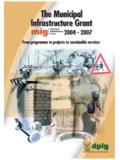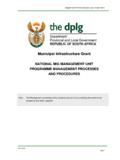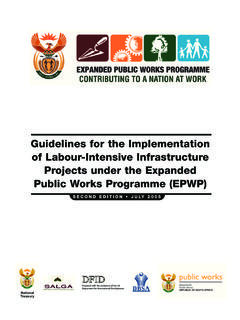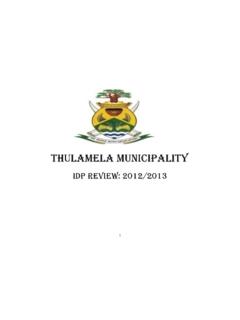Transcription of Public works - National Treasury
1 133 8 Public works Introduction Public works encompasses engineering, construction and related activities carried out by government for the benefit of citizens. This includes the acquisition, leasing, maintenance and disposal of immovable assets held by the state. Public works is a concurrent function and is a shared responsibility of National , provincial and local government. Public works contributes to government s New Growth Path, National Development Plan and Outcome 4: Decent employment through inclusive growth. The construction and maintenance of economic infrastructure and social infrastructure (schools, community libraries, hospitals and clinics) create opportunities for labour-intensive and technical or professional employment.
2 This directly addresses several outputs of Outcome 4, including faster, sustainable and labour-absorbing growth, increased competitiveness and accelerated implementation of the Expanded Public works Programme (EPWP). One of the roles of Public works is to provide office and institutional accommodation for National and provincial departments and in this way to assist them to function effectively. It also provides residential accommodation for members of parliament and of provincial legislatures. The size of government s portfolio of immovable assets makes it a significant player in the built environment.
3 The National Department of Public works (DPW) develops and enforces rules and regulations for the built environment and the use of fixed assets in the Public sector. Public works is also mandated to support transformation of the construction industry and to develop small, medium and micro enterprises, cooperatives and non-profit organisations. In doing so, it helps to empower individuals and communities from historically disadvantaged backgrounds. Public works contributes directly to government s economic growth and employment-creation priorities Public works goals include transforming the construction industry and supporting small business PROVINCIAL BUDGETS AND EXPENDITURE REVIEW: 2010/11 2016/17 134 This chapter reviews the current Public works landscape, budget and expenditure trends and service-delivery achievements.
4 Current landscape The Constitution defines the roles and responsibilities of National , provincial and local government in relation to Public works . National The National DPW provides the broad policy and legislative framework for the sector. This is generally done on a consultative basis, with key inputs from provincial and local government. To ensure that policy formulation is underpinned by consensus, the Minister of Public works meets regularly with members of provincial Executive Committees in this portfolio. The National department coordinates the implementation of the EPWP, supports transformation within the construction sector through the Construction Industry Development Board (CIDB) and provides and manages accommodation for National departments.
5 National Public entities Four main Public entities support the sector directly or through regulatory processes: The CIDB provides strategic direction for sustainable growth and reform of the construction sector and its role in the economy. It promotes best practices in relation to the performance of Public and private sector clients, contractors and other participants in the construction sector. The Council for the Built Environment presides over various professional councils. It reviews the legislation governing the councils and has in place a skills development programme. The Independent Development Trust helps to implement the EPWP and other infrastructure projects and programmes.
6 The Property Management Trading Entity, on a cost-recovery basis, finances the purchase, construction, refurbishment and maintenance of nationally owned government properties as well as the leasing of private-sector-owned properties by National government. On a commission and full-cost recovery basis, the entity also pays for municipal services on behalf of National departments. Provincial The Constitution assigns concurrent powers to provinces for the construction, maintenance and management of fixed (or immovable) assets. These functions are fulfilled in support of services delivered by other provincial departments.
7 Provincial Public works departments have significant levels of responsibility for infrastructure in social and economic sectors areas such as health, education, community safety and agriculture. As Table shows, provincial Public works departments are often combined with roads and transport departments, and generally have two broad spending programmes: Public works infrastructure and expanded The National Department of Public works operates in partnership with the provincial departments Four main entities support Public works delivery and regulation: the Construction Industry Development Board, the Council for the Built Environment, the Independent Development Trust and the Property Management Trading Entity Provinces have a growing responsibility to provide infrastructure in the social and economic sectors CHAPTER 8.
8 Public works 135 Public works (known as community-based programmes in some provinces). Public works , Roads and TransportTransport and Public WorksRoads and Public WorksPublic WorksMpumalangaWestern CapeEastern CapeFree StateNorth WestNorthern CapeGauteng (Infrastructure Development)KwaZulu-NatalLimpopoSource: National Treasury provincial databaseTable Public works , roads and transport functions per province, 2013/14 Public works infrastructure Through the Public works infrastructure programme, provincial Public works departments support the planning, design, construction and maintenance of provincial buildings, and provide accommodation for provincial departments.
9 This aspect of the Public works sector was enhanced by the Government Immovable Asset Management Act (GIAMA) (2007), which became applicable to provinces in April 2010. The Act provides a uniform framework for the efficient management of immovable assets, and coordinates the use of such assets with service-delivery objectives. Public works reforms Decentralisation of infrastructure budgets Until 2002, National departments capital or infrastructure requirements were budgeted for directly within the vote of the National DPW. However, in line with the Public Finance Management Act (1999), expenditure associated with a department s operations or activities must be accounted for directly through that department s vote.
10 As a result, capital budgets were devolved from the National Public works vote to individual departments budgets. Departments infrastructure requirements are therefore now met by using the National and provincial departments of Public works as implementing agents, with funding from the capital budgets of the departments concerned. Devolution of property rates In 2008/09, the function and budget for property rates on provincially owned properties was devolved from the National DPW to its provincial counterparts. The Devolution of Property Rates Fund grant was established to provide funding for the function shift and to ensure that by the time funds were included in the equitable share, budget requirements for property rates were relatively stable and predictable for better planning and accountability.















